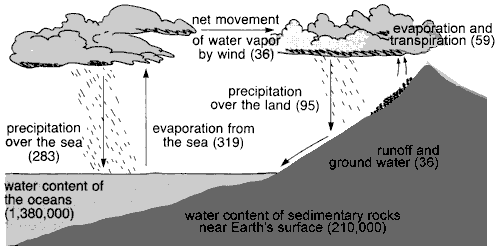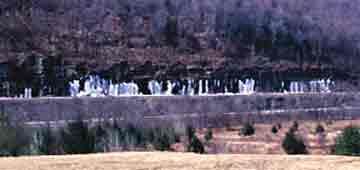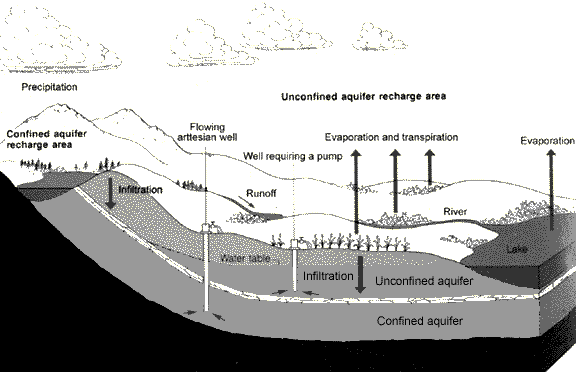| |
Water comes to earth in the form of precipitation, thereby initiating the hydrological cycle.
Atmospheric Water Vapor  The water cycle, with its major components expressed on a global scale. All pools and transfer values (shown in parentheses) are expressed as billion billion (1018) grams and billion billion grams per year. (After Hutchinson, 1957; Barry & Chorley, 1970.)
Ricklefs, Ecology, 3rd ed. |
Cloud formation is essential for the process (see Cloud formation), and regardless of where rain falls on the ground, the substrate becomes eroded due in part to the natural acidity of rain water. Each time it rains, a portion of earth (rock, sand, humic deposits, etc.) dissolves and either washes into surface water, or seeps into the ground and becomes part of the aquifer.
| A. Dissolved Inorganic Compounds |
- Calcium
- Magnesium
- Sodium
- Iron
- Sulfate
- Chloride
|
B. Particulate Inorganic Compounds |
- Slit
- Suspended Materials
|
| C. Dissolved Organic Compounds |
- Nitrogen
- Phosporous
- Bicarbonate
|
| D. Particulate Organic Matter |
- Bacteria
- Algae
- Leaves
|
| E. Dissolved Gasses |
- Oxygen
- Nitrogen
- Carbon Dioxide
- Methane
- Hydrogen Sulfide
|
Patterns of rainfall vary from year to year, and extreme variations in precipitation have profound effects on the health of millions of people who are dependent upon a predictable pattern of rain for the success of their crops, reliable amounts of drinking water, and water for use in various industrial processes. When these patterns are interrupted by, for example El Niño and La Niña events, floods, droughts and other extreme weather catastrophes cause countless deaths and much human suffering, not to mention their devastating effects on ecosystem services. The advent of monitoring atmospheric hot house gasses has lead most ecologists to the conclusion that the earth's temperature is on the rise. Anthropogenic greenhouse gases "force" the atmosphere to absorb more solar radiation and keep it within the confines of the lower layers, thus adding to the heat budget of earth. Hence, global climate change is a concept whose time unfortunately has come. Long range predictions of climate change is, however, still a dream wish, rather than a reality. Even the most sophisticated atmospheric models of the earth's weather still fail at more than a one week long forecast. Accurate, predictable atmospheric circulation models remain at the top of the list of unsolved earth science mysteries.
Surface contaminants, both point source and non-point source, can end up either in the aquifer or in surface waters.
Once a water supply is contaminated, particularly groundwater supplies, it can take years, perhaps even hundreds, for the offending substance to become diluted below the limit of detection. Remediation of aquifers and surface waters is another goal high on the list of environmental engineers.
Natural deposits of heavy metals that are harmful in high concentrations (e.g. Hg, As, Pb) are usually diluted by rivers, lakes and groundwater that receive surface runoff from natural deposits. Rarely, the source of drinking water becomes contaminated with a high enough concentration of a heavy metal to raise concerns about its safety for human use. Such is the case for portions of Bangladesh and eastern India, where naturally occurring deposits of arsenic have resulted in a serious health hazard for millions of people who rely on water from the aquifers in those regions for drinking, bathing, and recreation. Prior to 1999, those same peoples relied solely on surface water and suffered the ravages of a wide variety of infectious agents that cause diarrheal diseases. By switching to groundwater they avoided those problems only to face potentially more serious ones.
| |
 |
| |
Frozen water exiting an aquifer (Photo by D. Despommier) |
| |
|
Agricultural run off containing minute amounts of fertilizers, pesticides and herbicides, can also concentrate in groundwater associated with aquifers that underlie farmland. The Imperial Valley of California receives water from an intricate series of interconnected irrigation canals. The water is used to grow a wide variety of crops and when the plants take up as much as they can, the excess water percolates down into the soil and remains there. Traces of heavy metals, particularly selenium and aluminum, present in fertilizers in minute amounts, begin to accumulate in the aquifer as the water evaporates off. Today these metals have exceeded the tolerance limits for waterfowl and other wildlife in certain regions of the valley. In addition, the water table is almost at the level of the surface, due to over use of irrigation and the geography of the entire valley, which is bowl-like in shape. Nothing liquid drains away from it, and as the water evaporates away, the contaminants continue to increase in concentration. Remediation is the only hope for saving a large part of what was once referred to as the "bread basket" of the world.
The problem is the reverse in south-western Kansas, where wheat farmers have used the Ogallala aquifer for some 50 years with much success. The presence of cheap natural gas close by enabled them to pump out the water from 50-60 feet down. Without groundwater, wheat farming would not be possible in that ecosystem of semiarid tall grassland prairie. Today, however, the water table is much lower due to over use, and the pumps that run on natural gas are not powerful enough to lift the water from deeper than 100 feet. Oil pumps will do the job, but the fuel and the pumps themselves cost much more— so much more that the cost-benefit to the farmer is below the margin of profit. Soon, wheat farming in western Kansas will come to a halt, and as a result, the price of wheat will surely go up. How high it will go is hard to predict, but the increase will surely place a strain on people in the lower economic brackets who rely on low prices for their daily bread, and may even force them away from a healthy diet to one less enriched in essential nutrients. In addition, people in Kansas who depend upon wheat farming will have to find something else to do, and in the meantime, their families may suffer "financial withdrawal symptoms" that may carry a health risk with it. Clean, contaminant-free water is a most valuable commodity that is provided to us by natural systems that filter it and maintain huge underground reserves. Misusing water creates situations that place us at risk from diseases caused by infectious organisms, cancer causing agents and reduced supplies of drinking water. The applications below illustrate these points with real cases.
|
Diagramatic Representation of Aquifers  |
[Back To Top]
|
|